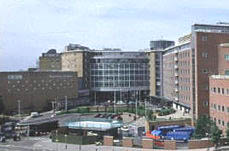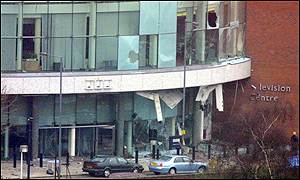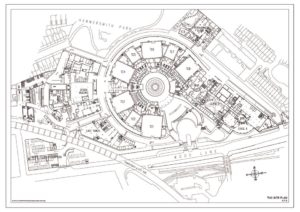Stage 6 was, as we have seen, very nearly a superb television studio that would have been the envy of the whole industry. Nearly, but not quite. During the ’70s and ’80s the entertainment department had been putting pressure on the BBC’s senior management to construct a new studio in the remaining space at the end of the spur at TVC. It would replace Television Theatre but would be far more flexible in its use. It was to have a floor area about 98 x 85ft wall to wall but with the addition of large audience rostra on two levels. (So somewhat larger in both length and width than LWT’s studio 1). The BBC producers were fed up with the way that LWT’s big shows looked so much more impressive than theirs made in TC8. Even TC1 didn’t look as good once you filled it with the usual mobile seating.
Detailed plans were drawn up over several years for this new TC9. It was to have a grid height of 72 ft (TC1 is ‘only’ 45ft high) which would enable scenery to be flown on counterweight systems. There would be permanent audience rostra seating 400 which could be extended with moveable ‘wings’ and the studio would have its own foyer, make-up, wardrobe and scenery handling areas. There was even to be a large band room with its own control room – oddly duplicating the new music studio a few yards away in stage 5 which was almost exactly the same size.
Terry Brett was asked to represent the lighting side of things. He was a busy LD at the time but attended many meetings of the steering committee. He told me in 2006 that he was still waiting for someone to inform him that the project had been cancelled – let alone thank him for all the work he put in.
According to Terry, there were a couple of problems with the studio’s design that had to be overcome. One concerned the trough that was to run round the bottom of the cyclorama so that groundrow lights could be hidden, thus creating an ‘infinity cyc’. One challenge was how to create this trough whilst still leaving enough headroom in the news department garage beneath. Terry describes another issue that arose:
‘…being the BBC it had to have handrails to protect the terminally stupid. However, in the end the trough lid became the safety device on the outer side. The trough had to be engineered to allow camera tracking when the studio was in sitcom mode and the cover strong enough to take camera cranes and just about anything else that could be thrown at it. Also it had to be deployed quickly so as to speed up turn-rounds. The final solution was to have the trough covered by a concrete ‘lid’ which could be hydraulically raised. Now as most builders at that time worked to the nearest inch at best, the construction of this monstrosity was going to be a challenge. However, unbelievably the challenge was met! (I have seen a video of the system being tested and it is very impressive.)
Secondly, there were problems in keeping the studio ventilated. With such a high cyclorama containing the heat, someone came up with the idea of dropping the ventilation to the level of the lighting rig. Now this brought some strong protest from many, not the least me. The amount of space lost in the hanging rig would have been unbearable. It was then suggested that the ventilation trunking should be flexible and fitted to the LX bar suspension. i.e. as the bars came down, the trunking came down with it – albeit a few feet above the bar itself. This was built and a demo section was installed somewhere in the depths of Woodlands.
Such was the ability of the old BBC to innovate – where did that all go? In retrospect the noise from those pop riveted lamps heating up and cooling down would have given sound something to think about.’
Before stage 6 was built in 1998, the ring road past TC8 came to an abrupt end and a ramp took it down to the level of the front car park. Terry tells me that somewhere under the ramp a couple of experimental sections of trough were built complete with hydraulic lids. I wonder if it’s still buried under there…???
Cameraman Jeff Naylor was asked for his advice on a particular issue…
‘One addition to the plans for the new TV Theatre was for a remote-head camera crane such as a Louma – I distinctly remember the plans from a meeting where I discussed where it could be mounted and the compromises it would force on the lighting rig, in particular the followspot positions – as I wanted to hang it over the edge of the Circle!’
I see that some things never change.
The idea was to close TV Theatre and transfer Wogan, or the show’s successor, to the new studio. It would also of course be available for other big Saturday night shows. There is little doubt that this studio would have become the best equipped LE studio in the country and would have been much in demand for big gameshows and music/entertainment shows. Sadly, despite all the work done on the project it was abandoned very soon after Michael Checkland became DG. The studio had been enthusiastically supported by Bill Cotton but it was cancelled within a week of his retiring from the job of Managing Director of Television in 1989.
It was becoming fashionable with some around that time to declare the age of the big TV studio over. Also, the new director general and his assistant John Birt were introducing far more stringent financial control over all the BBC’s costs and expenditure – so with accountants rather than programme makers running the BBC the project didn’t stand a chance. If only construction had begun a few months earlier it would almost certainly have been completed and become the busiest studio in London!
Instead, TC1 – which was due to be refurbished – would be given a more fundamental refit, with built-in retractable audience seating and redesigned stairs with a new glazed foyer area at first floor level for the audience. After nearly three years work the ‘new’ TC1 opened in January 1991 but was not a patch on what might have been.
The legacy of the old plans could be seen in the rather oddly shaped curved podium that extended from the base of Stage 6 towards the Horseshoe carpark. This was part only of what was going to be the grand entrance to the new theatre leading in turn to the foyer on the first floor and taking audiences into the main studio auditorium at the back of the seating (as happens in West End theatres). There was even an idea for LED lights announcing tonight’s performance displayed around the semi circular facade above the entrance doors. Stage 5’s rear elevation made a bit more sense too when the original proposals are understood.

Personally, I think the original spur and stage 5 are particularly disappointing but the design of stage 6 is much more in keeping with Dawbarn’s design. It contains several details and features that echo the main block and its mass is far better balanced. It’s still a shame that the bricks are not the same colour!
So what did become of stage 6? Well, it became the BBC’s News Centre. It was opened in July 1998 by Sir Christopher Bland. It seemed a good idea to John Birt to bring radio news away from Broadcasting House in central London to join TV news several miles away at Television Centre. Guess what? The journalists didn’t like it. So Greg Dyke gave the go-ahead to rebuild much of Broadcasting House to take the radio news back there as well as the TV news. They eventually returned in March 2013.
Stage 6 was also finished off with a new reception area complete with Henry Moore sculpture (later removed), facing Wood Lane. It all looked very smart and businesslike. The old reception became the ‘stage door’ and still occasionally featured on various shows.
Stage 6 opened in July 1998 and the Real IRA tried to blow it up in March 2001 with a taxi parked outside. Fortunately, nobody was hurt. Although the damage looked superficial (one assumes that such an attack had been foreseen) it took about two years before the scaffolding came down and an even stronger bombproof wall of glass was revealed.

TV Centre reception the day after the bomb.
TVC came under attack on several occasions over the years. Apart from the Real IRA, it was surrounded by thousands of screaming pubescent girls when bands such as Take That performed on Saturday morning kids’ shows. If you don’t think that sounds too bad you should have been there!
Only slightly less scary was the occasion when evangelical militant Christians tried to prevent people from entering or leaving the building during the Jerry Springer the Opera controversy in January 2005. Then, when leader of the BNP Nick Griffin appeared on Question Time in TC6 on 22nd October 2009, several hundred angry protestors demonstrated outside the gate – about 25 breaking in as far as the Stage Door (the former main reception). On the same night three other audience shows were also being recorded – Harry Hill’s TV Burp (TC3), Friday Night With Jonathan Ross (TC4) and Piers Morgan’s Real Lives (TC8). About 1,000 ordinary punters with tickets therefore had to be got into the building past the shouting protestors – as well as the QT audience and the panelists – but somehow the security staff did it – and got them out again safely.
I should declare an interest here, having lit the televised version of Jerry Springer the Opera, several editions of Live and Kicking and been in the building lighting TV Burp on the night of the BNP Question Time. (For the record, the ignorance shown by many of the protestors of what was actually depicted in Jerry Springer the Opera was astonishing and proved to me how otherwise intelligent people can be hoodwinked into believing anything if instructed by skillful and manipulative leaders. At least I had seen the show – several times – which most of those interviewed clearly had not.)
Other incidents have included the women’s invasion of the 6 o’Clock News in 1988 when Sue Lawley kept her cool and Nicholas Witchell sat on a lesbian. Meanwhile, in March 2000 a media studies student vaulted over the low turnstile in main reception and found his way to the main newsroom. He is said to have gone on the rampage, causing thousands of pounds worth of damage, getting ‘within feet’ of Anna Ford. Having smashed monitors and thrown a coffee table through a window, he explained afterwards that he was upset by Greg Dyke’s style of leadership and thought the licence fee was too high. Apparently he threatened to kill anyone who tried to stop him but fortunately somebody did and he ended up in a mental hospital.
This happened incidentally after security had been tightened following the murder of Jill Dando. After that, access from reception into the building was completely redesigned with a high glass wall containing motorised turnstiles that only let one person through very slowly and could, in theory, trap someone half way round.
Then there was the invasion of the live Lotto draw in TC4 during Jet Set on 20th May 2006. This was by six members of Fathers for Justice, one of whom allegedly received a distinctly less than friendly welcome from presenter Eamonn Holmes. The director cut to a close-up of him remaining calm and collected but those working on the show have told me what was happening just out of shot! Respect due to Mr Holmes. Soon afterwards, Camelot decided to move the draws to the rather more secure ex-British Forces Broadcasting Service (SSVC) studios run by Arqiva in Buckinghamshire.
Construction and refurbishment continued at TVC for the whole of its life. Individual rooms and whole floors were from time to time gutted and rebuilt. Studios too were given refurbs every few years. The running of the building itself was taken out of the BBC’s hands in 2001 and became the responsibility of a company called Land Securities Trillium. (No connection with the Hitch-Hiker’s Guide to the Galaxy. Oh sorry, that’s Trillian).
The early days of this new operation were sometimes not as smooth as they might have been. A studio resources manager has told me a story that cannot possibly be true. Allegedly, shortly after Land Securities Trillium took over, he phoned the new number to ask for the air conditioning to be made cooler in the studio he was working in. He was connected with an office in the north of England. The operator requested the studio’s ‘room number’, what floor it was on, the address of Television Centre and various other details. Finally, he was told the job number and informed that the work would be carried out next Tuesday. Thankfully, I believe this and other similar teething troubles were ironed out within a few weeks.
In July 2006 the contract to supply facilities management passed to a company called Johnson Controls. I assume they too learnt pretty quickly to adjust studio temperatures faster than next Tuesday.






